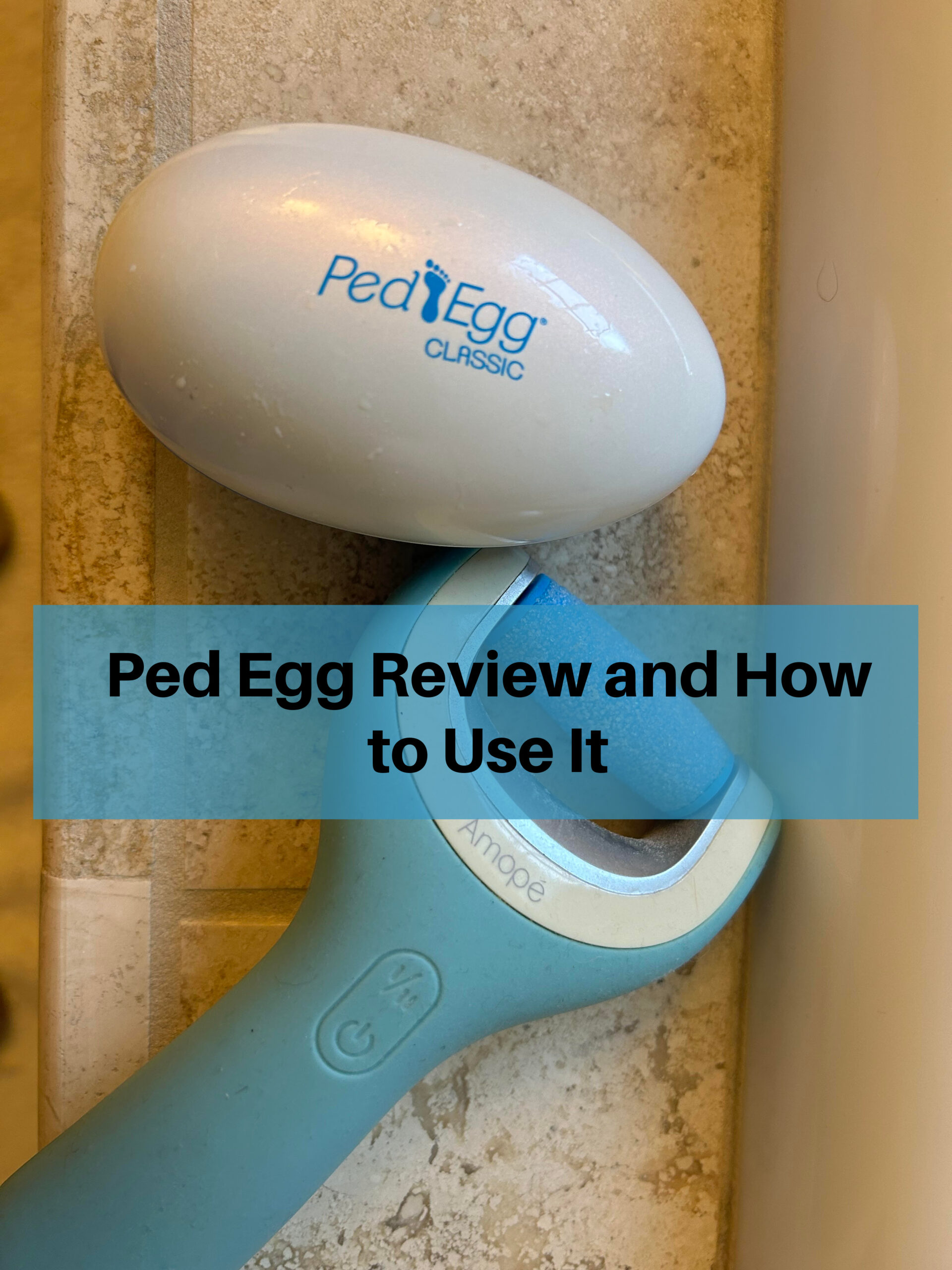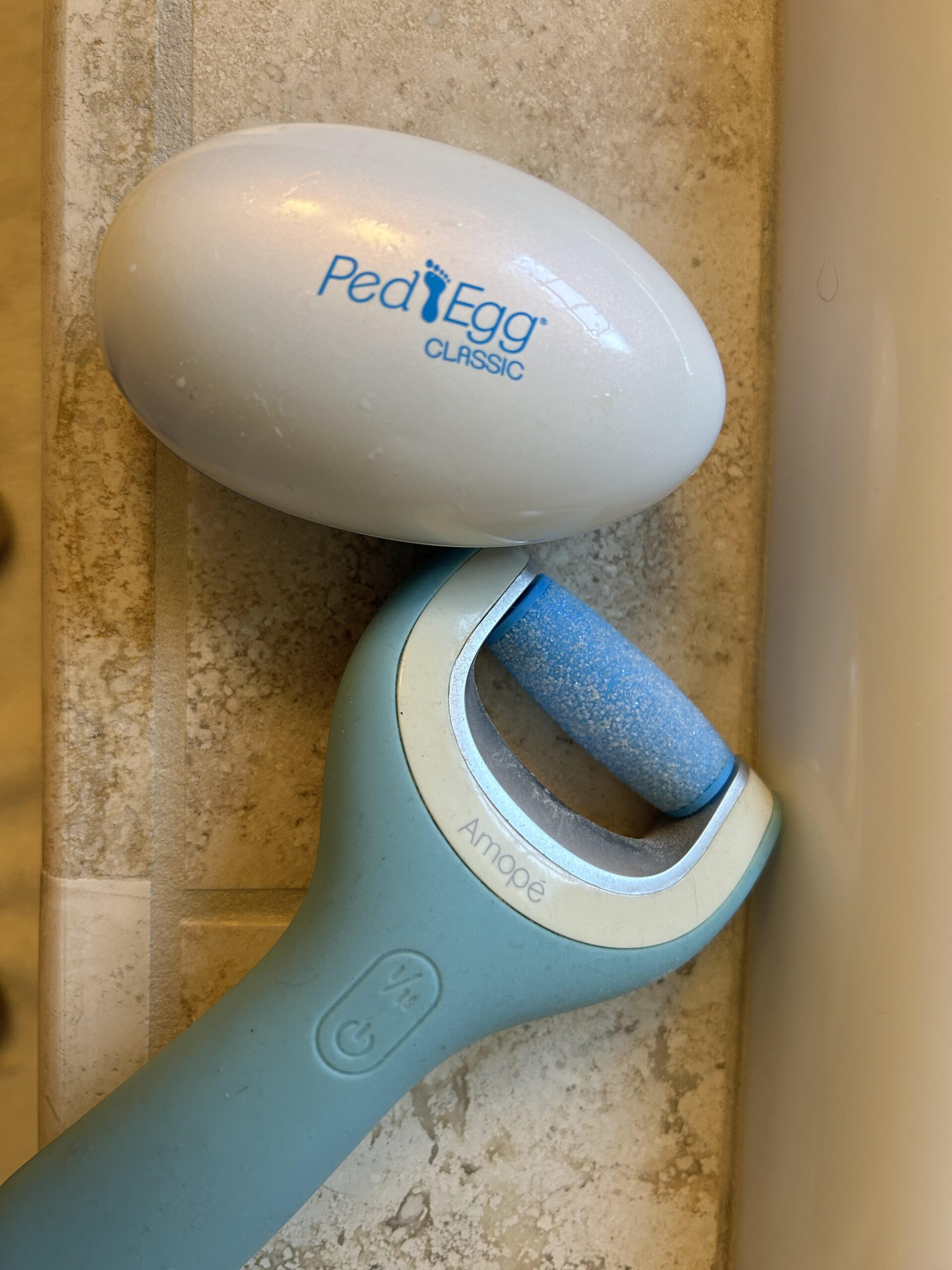Removing Calluses with the Ped Egg
I love my Ped Egg foot file! I seriously think that every callused foot on the planet deserves one! It works much better for me than pumice stones or even my beloved Amope foot file, which don’t get me wrong, I still adore, but I use my ped egg as a callus remover and the Amope more as a smoother.

When I first read about the Ped Egg on tv as a way to remove calluses, I wanted to try it. It gets consistently good reviews and, as I often mention, I’m hard on my feet and the callus battle is constant for me. I have had success with various foot files and tools, but nothing has worked as well for me as the Ped Egg. I do a lot of running so I have calluses and dry feet with hard skin, I really wanted a way to get soft feet in my life again.

About the Ped Egg
The Ped Egg is a little plastic egg with a foot file inside. This is not a callus razor, but is more than a sandpaper or pumice type of file. It generally is similar to a metal foot file, with a cheese grater look to it. Designed to be gentle, you can run it over your smooth skin without a scratch, but on calluses it grates and files them away, and it does so very quickly. The dead skin shavings are collected inside the egg, so there is also less mess. Fine grain file pads are also available for creating a smooth finish.
The original ped egg egg is designed to fit in the palm of your hand. In the past I saw a ped egg with a handle but I can’t seem to find that now. Another product substantially similar to the Ped Egg is the Revlon pedicure kit foot file. I have that one too and consider them interchangeable.
One nice extra on the Revlon file is the backside has a fine texture file. However, I find I actually don’t use that much. I sue the Amope for that function. Here is a photo for comparison.
You can see my Amope Reviews at this Amope Tag Page.

PeEd Egg Review, Does it Work?
When I used the Ped Egg, I removed most of a fairly large heel callus in a matter of minutes. I had been doing some preparation using Glycolic Acid from AB Skin Care and some foot cream (read previous article), which also had softened things up a bit. I did find that if I held the egg tilted, too much that the dead skin would fall out, so to keep the skin in the egg where it belongs don’t tilt your egg too much!
I finished off my feet with the file pad, added some moisturizing cream, and my feet were ready for a new pair of summer sandals!
I have also tested using the product on wet skin after the calluses have softened. The egg works well that way too, but I prefer using it on dry skin, working on the particularly dry area over a series of days. I use my Amope, which is a power device, more on we skin to smooth the area and remove small dry patches of dead skin.
Overall, the conclusion of my review is that I highly recommend the product. It is affordable and one of the best ways to quickly address calluses that I know of. If you ae looking for a quick way to get sexy feet worthy of sandals, the Ped Egg is the way to go.

How to Use the Ped Egg Foot File?
First off, the efficacy of the Ped Egg Foot File i depends in part on several factors:
Severity of Calluses
? The Ped Egg Foot File is more suitable for addressing moderate calluses and dry skin. For severe cases, professional intervention may be necessary. Although I have used it on some pretty tough calluses with a lot of success.
Consistency
Regular and consistent use of the Ped Egg is key to achieving noticeable results. Incorporating it into your foot care routine, perhaps once or twice a week, can lead to gradual improvements. For tough calluses I use it daily until I have the callus worn down.
Technique
Proper usage technique is vital for optimal results. Applying too much pressure or being too aggressive can lead to discomfort. Using gentle, controlled motions is recommended. For a really thick patch, you can use more pressure, but for general small calluses, be gentle!
How to Use the Ped Egg and Similar Devices
To make the most of your Ped Egg Foot File and ensure your feet are treated safely and effectively, follow these steps:
- Clean Your Feet: Begin by washing and drying your feet thoroughly. This helps to remove any dirt or debris that could interfere with the exfoliation process.
- Choose the Right Time: Decide whether you are using the product wet or dry. It we, it’s best to use the Ped Egg after a shower or bath, when the skin is softened due to the exposure to warm water. I personally use mine dry though.
- Gentle Strokes: Hold the Ped Egg in your hand and gently glide the grating surface over the areas with calluses or dry skin. Use light pressure and avoid excessive force to prevent skin irritation or damage.
- Frequent Checks: As you exfoliate, periodically stop to assess the progress. This helps you avoid overdoing it and prevents unintentional removal of healthy skin.
- Optional Additional Smoothing: Further Smooth with a pumice stone of Amope. I like run my Amope over the area to smooth it out. A Pumice stone works well for this too.
- Moisturize: After exfoliating, apply a moisturizer or foot cream to nourish the newly exposed skin. This step helps maintain the smoothness and softness of your feet.
- Clean the Ped Egg: Regularly clean the Ped Egg to remove the collected dead skin. This ensures hygiene and keeps the tool in good condition.

Where to Buy
The Ped Egg is widely avaialbe at drug stores and big box retailers such as Walmart, Target, CVS. Rite Aid, or Walgreens.
You can also easily buy it here on Amazon.
Overall. t he Ped Egg foot file can indeed be a valuable addition to your foot care routine. When used correctly and consistently, it can help alleviate rough, calloused skin and promote healthier, smoother, beautiful feet. Remember, moderation and proper technique are key. While the Ped Egg Foot File isn’t a substitute for professional podiatric care, it can play a role in maintaining foot health between visits. So, take a step towards better foot care with the Ped Egg and enjoy the comfort of revitalized feet.
